The Dell XPS 13 (9300) Review: Return of the King
by Brett Howse on July 16, 2020 10:00 AM ESTGPU Performance
One area where Intel-based notebooks had previously was in the graphics department, and with Intel’s launch of Ice Lake they directly addressed that. Along the way, Intel has also joined AMD in more aggressively demarcating their integrated GPUs based on the price of the processor. Intel always had a small bit of variation in the included GPU, but for the most part, a Core i3, i5, or i7 U-series would generally offer the same 24 Execution Unit GPU configuration. With Ice Lake, the naming scheme now includes the GPU size in the processor name, with G1, G4, and G7 graphics options, meaning lower-priced Core i3 and i5 models will not necessarily be outfitted with the same iGPU as a Core i7.
| Intel 10nm Ice Lake-U Series CPUs | |||||||||
| AnandTech | Cores Threads |
Base Freq |
1C Turbo |
AC Turbo |
GPU EUs |
GPU Freq |
L3 Cache |
TDP | |
| Core i7-1068G7 | 4 Cores 8 Threads |
2.3 | 4.1 | 3.6 | 64 | 1100 | 8 MB | 28 W | |
| Core i7-1065G7 | 4 Cores 8 Threads |
1.3 | 3.9 | 3.5 | 64 | 1100 | 8 MB | 15 W 25 W |
|
| Core i5-1035G7 | 4 Cores 8 Threads |
1.2 | 3.7 | 3.3 | 64 | 1050 | 6 MB | 15 W 25 W |
|
| Core i5-1035G4 | 4 Cores 8 Threads |
1.1 | 3.7 | 3.3 | 48 | 1050 | 6 MB | 15 W 25 W |
|
| Core i5-1035G1 | 4 Cores 8 Threads |
1.0 | 3.6 | 3.3 | 32 | 1050 | 6 MB | 15 W 25 W |
|
| Core i3-1005G1 | 2 Cores 4 Threads |
1.2 | 3.4 | 3.4 | 32 | 900 | 4 MB | 15 W 25 W |
|
This comes into play since Dell offers three processor options on the XPS 13, with both the Core i3 and Core i5 variants only offering the G1 graphics. To be clear, even the G1 Generation 11 graphics on Ice Lake are a larger GPU than the previous Gen 9.5 offered, with even the lowliest Core i3 featuring 32 Execution Units, but the full GPU in this laptop is only found if you choose the Core i7 model, which offers the 64 Execution Unit G7 graphics. It makes choosing the processor a bit more complex than it used to be, as it would be on an AMD-based laptop which follows the same mantra.
Dell shipped the XPS 13 review unit with the Core i7-1065G7, and as such this device does feature the full-sized GPU, and as we have seen in other Ice Lake based notebooks, the larger GPU is a significant improvement over previous designs.
3DMark
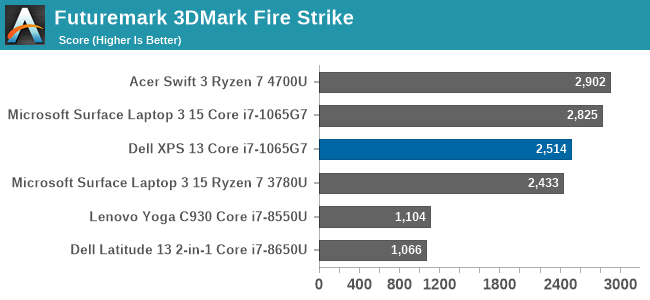
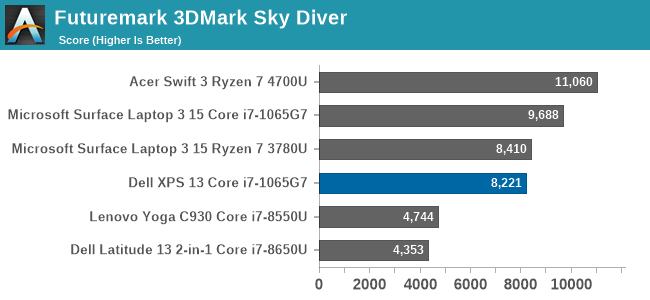

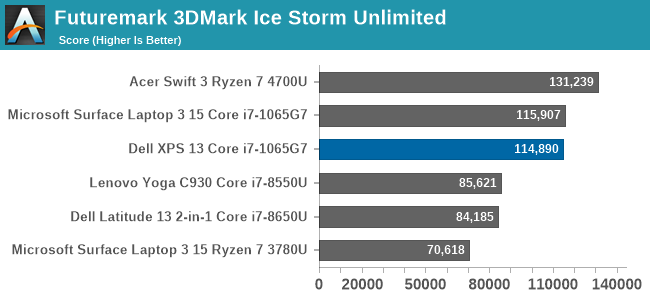
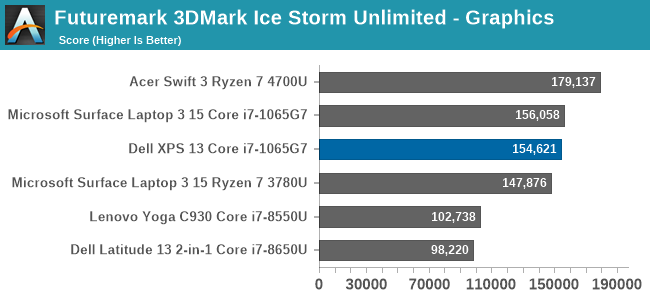
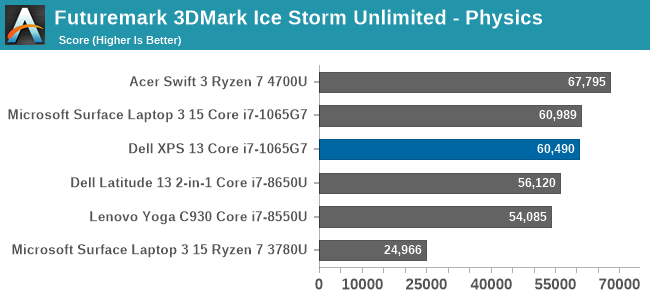
In our first synthetic test, the XPS 13 finishes slightly behind other Ice Lake notebooks, but not by a wide margin.
GFXBench
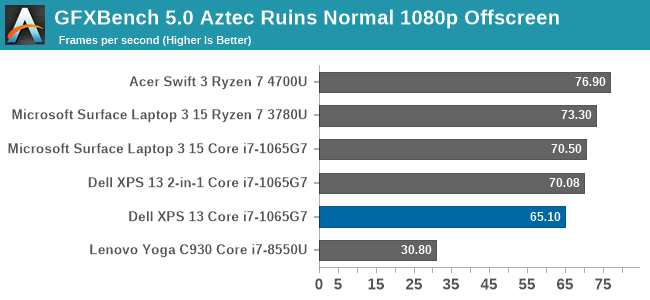

We run the DirectX 12 tests from version 5 of GFXBench, and as expected, the XPS 13 scores right in the same range as expected.
Tomb Raider
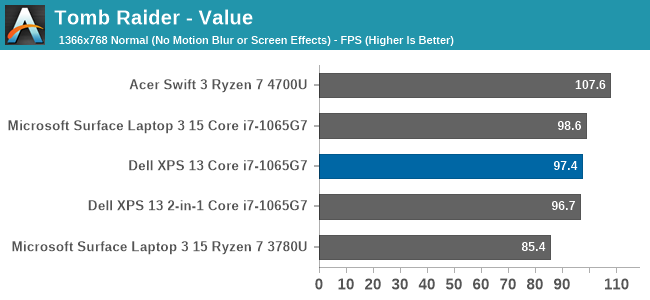
The original Tomb Raider has been a challenge on integrated GPUs, but with AMD’s Ryzen and Intel’s Ice Lake, the game is finally playable although without any extreme graphics settings enabled. Once again, the XPS 13 slots in right where it is expected.
Rise of the Tomb Raider
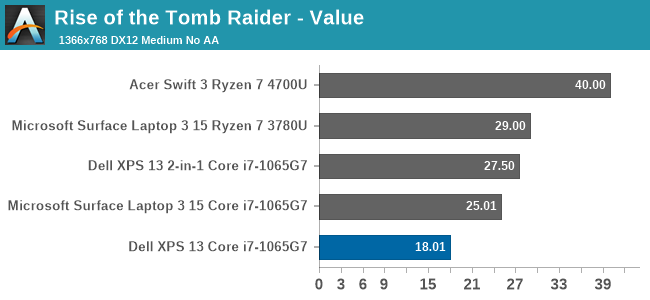
The first sequel to the re-launched Tomb Raider series is much more graphically demanding, and the XPS 13 slides out of the playability window even at the lowest settings we test at.
Strange Brigade
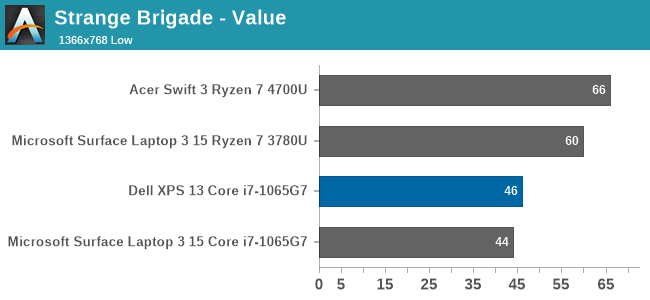
Strange Brigade is a game with a wide-range of settings, and can be very playable even on integrated graphics. As seen with Rise of the Tomb Raider though, the XPS 13 is not quite as performant as some of the other Ice Lake notebooks we have tested.
F1 2019
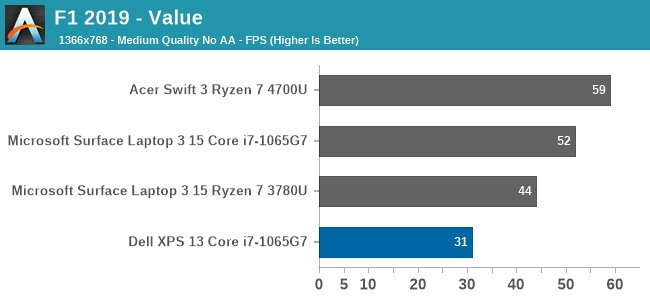
Codemaster’s F1 simulator did not fare very well on the XPS 13, scoring well under expectations. This game can be very CPU limited as well, so TDP can be a major factor.
Far Cry 5

Like most of the other games, we see that Far Cry 5 is once again below other Ice Lake systems, but even on the best integrated system Far Cry is only barely playable regardless.
GPU Conclusion
Although the XPS 13 was outfitted with the top of the range Core i7-1065G7, with its full 64 Execution Unit GPU, the XPS 13 was not quite able to match some of the other Ice Lake systems we have seen. We will get into that a bit more in the thermals section, but this is likely due to Dell more aggressively clamping the processor to its recommended 15-Watt TDP, where other manufacturers may be more aggressive and allow 20+ Watts. Since the GPU is one area where more thermal headroom is always welcomed, this can have a larger impact than a CPU-bound task.
Otherwise, while the Ice Lake G7 GPU configuration is nothing short of a massive step up from Intel's earlier integrated GPUs, they are also competing with AMD in a field that's normally AMD's strength. So for as fast as the G7 configuration is, it and the XPS 13 end up trailing laptops based on the half-a-generation newer AMD Ryzen 4000 APUs.










224 Comments
View All Comments
grant3 - Friday, July 17, 2020 - link
There's an excellent reason why ultrabooks might underperform: their cooling capacity is limited by the form factor.If CPU performance, or price:CPU Performance, were the only metrics which mattered to people, then ultrabooks & apple would not exist.
Spunjji - Monday, July 20, 2020 - link
@grant3 - the cooling system on that Acer Swift is pretty terrible!@Deicidium - the XPS 13 9300 launched in January this year - that's 6 months ago. It's the current competition for AMD's current mobile chips that launched one month ago. A comparison with a product that hasn't released yet isn't "more appropriate". 🤦♂️
Deicidium369 - Friday, July 17, 2020 - link
Ice Lake is almost a year old. The more appropriate comparison is the upcoming Tiger Lake, Anandtech has been slow to get a review unit for an almost year old design, while the next gen is being prepped for release.Santoval - Friday, July 17, 2020 - link
"Valid" in what sense? sorten is giving Intel a competitive benefit (or, alternatively, gives AMD a handicap) by comparing an AMD "craptop" with an Intel ultrabook; it's not the other way around.Spunjji - Friday, July 17, 2020 - link
Performance: No, not for Ice Lake.Power Consumption: Yes, but only for Ice Lake.
Price: Not even funny.
When you combine all three AMD currently come out easily on top, and yet...
Meteor2 - Thursday, August 20, 2020 - link
It's incredible how much people can argue about objective numbers.Deicidium369 - Thursday, July 16, 2020 - link
Tiger Lake is coming in the next month or so - Lenovo and Acer already have their systems working the Tiger Lake Core i7-1165G7 - 4 core + 96EU Xe LP wrecks the most powerful Renoir in iGPU (actually matching or slightly exceeding the MX350) and with double the CPU cores (4 Intel / 8 AMD) the AMD is only 17% ahead. So Yeah, way less performance from the AMD.Problem with AMD is they are still trying to get Skylake levels of performance, but Intel has well moved on from that architecture. Intel is solid as they come in ultralights/ultrabooks.
sorten - Thursday, July 16, 2020 - link
Not sure what you mean when you say "Problem with AMD is they are still trying to get Skylake levels of performance." Zen 2 mobile chips easily outperform Ice Lake and Comet Lake.Yes, we all expect the Xe iGPU to outperform AMD's iGPU. Intel has been humiliated for so long in this area that they've put all of their efforts into becoming competitive. In some respects, both brands targeted their competitor's strength, and gave up ground in theirs.
I'd personally prefer the CPU advantage, because if I'm doing anything with graphics that any decent iGPU can handle, I'd just use the Dell's TB3 port to hook up an eGPU. But everyone has their own priorities, I understand.
Cliff34 - Thursday, July 16, 2020 - link
The problem is that AMD doesn't support Tb3. So if you need Tb3 for anything you will end up buying Intel.PixyMisa - Thursday, July 16, 2020 - link
AMD does support TB3, as evidence by the fact that you can buy AMD devices with TB3.There just aren't many of them.